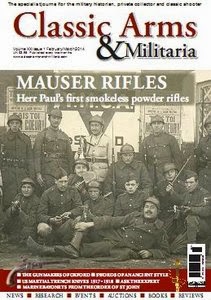Monday, February 24, 2014
Classic Arms & Militaria 02-03/2014
The widespread adoption of firearms which used metallic cased cartridges from about 1870 onwards created a requirement for inert cartridges to teach the soldier how to manipulate his weapon. This became increasingly important with die advent of magazine rifles. The only way that an instructor could be sure that his pupils had assimilated the lesson was to see them conduct a successful loading and firing cycle with inert ammunition. During the muzzle-loading era, the lack of dummy ammunition was not an issue. Loading drill could be conducted without it and lightly charged blank or "blunt" cartridges could be used when necessary to give the soldier a better impression of his firearm's function. As firearms grew more technically complex, armourers and other artificers needed inert ammunition to check functionality and wear. Consequently, a new type of inert ammunition the Drill or Dummy cartridge began to appear. In 1871 die famous Scottish gunmaker Alexander Henry advocated a dummy cartridge for use in the .577 Snider rifle. The main part of the case and the tapered "bullet" were made from turned boxwood. The head was brass and the "primer" was an India-rubber plug designed to absorb die impact of the striker. Mr Henry patented his design (No. 3257/1870) and promoted it vigorously amongst die Volunteer Movement. He claimed that soldiers could "..make constant HOME PRACTICE without danger, expense or injury to the rifle and the manipulation is a perfect as though using live cartridges". Henry's dummy cartridges cost 2 shillings and 6 pence for 10 or 100 might be had for a guinea including rail delivery. Specimens are rare today.
Subscribe to:
Post Comments (Atom)

No comments:
Post a Comment